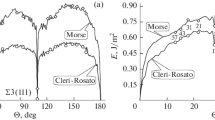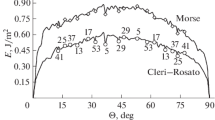Abstract
A structural vacancy model of tilt grain boundaries in metals has been developed. For construction of the stable structure of the boundary, the initial pattern was chosen according to the CSL model. The introduction of additional atoms and vacancies into the boundary region and shifting of atoms by the interatomic forces stabilize its structure. The criterion of a stable structure is the grain-boundary energy. The comparison of two main approaches to the stabilization of the grain structure demonstrated that changing the number of atoms at the boundary is more energetically advantageous than the relative shift of grains. The stability of the structure obtained has been studied under the shear stress. In the model developed, atomic structures obtained with pair and many-body potentials have been compared. The comparative analysis has shown that the grain-boundary structure does not depend on the choice of potential; atomic positions differ by less than 0.1 Å, which is 2.5% of the lattice parameter. The atomic structure is in agreement with experimental images of grain boundaries.








Similar content being viewed by others
REFERENCES
M. L. Kronberg and F. N. Wilson, “Structure of high angle grain boundaries,” Trans. AIME 185, 506–508 (1949).
V. V. Gorbunov and B. M. Darinskii, “Emission of vacancies by an intercrystallite boundary,” Fiz. Tverd. Tela 34, 1059–1063 (1992).
M. D. Starostenkov, B. F. Dem’yanov, S. L. Kustov, and E. L. Grakhov, “Symmetric Σ = 5 tilt boundaries in the Ni3Fe alloy,” Phys. Met. Metallogr. 85, 530–535 (1998).
A. S. Dragunov, B. F. Dem’yanov, and A. V. Weckman, “Computer simulation of internal interfaces in metals and alloys,” Izv. Vyssh. Uchebn. Zaved., Fiz. 53, 82–87 (2010).
M. A. Tschopp and D. L. McDowell, “Asymmetric tilt grain boundary structure and energy in copper and aluminium,” Philos. Mag. 87, 3871–3892 (2007).
A. N. Orlov, V. N. Perevezentsev, and V. V. Rybin, “Analysis of defects in the crystal structure of a symmetric tilt boundary,” Fiz. Tverd. Tela 17, 1662–1670 (1975).
V. V. Rybin and V. N. Perevezentsev, “General theory of grain boundary shifts,” Fiz. Tverd. Tela 17, 3188–3193 (1975).
W. Bollmann, Crystal Defects and Crystalline Interfaces (Springer Verlag, Berlin, 1970).
G. H. Bishop and B. Chalmers, “A coincidence-ledge-dislocation description of grain boundaries,” Scr. Metall. 2, 133–139 (1968).
L. K. Fionova, “Ordinary grain boundaries,” Phys. Met. Metallogr., 73, 333–336 (1992).
G. Hasson, J. Y. Boos, J. Herbeuval, M. Biscondi, and E. C. Goux, “Theoretical and experimental determination of grain boundary structures and energies: Correlation with various experimental results,” Surf. Sci. 31, 115–137 (1972).
M. F. Ashby, F. Spaepen, and S. Williams, “The structure of grain boundaries described as a packing of polyhedra,” Acta Metall. 26, 1647–1664 (1978).
R. C. Pond, D. A. Smith, and V. Vitek, “Computer simulation of 〈110〉 tilt boundaries: Structure and symmetry,” Acta Metall. 27, 235–241 (1979).
J. D. Bernal, “The Bakerian Lecture, 1962. The Structure of Liquids,” Proc. R. Soc. London, Ser. A 280 (1382), 299–322 (1964).
V. Vitek, “Intrinsic stacking faults in body-centered cubic crystals,” Philos. Mag. 18 (154), 773–786 (1968).
D. A. Smith, V. V. Vitek, and R. C. Pond, “Computer simulation of symmetrical high angle boundaries in aluminium,” Acta Metall. 25, 475–483 (1977).
M. J. Weins, H. Gleiter, and B. Chalmers, “Computer calculations of the structure and energy of high-angle grain boundaries,” J. Appl. Phys. 42, 2636–2645 (1971).
P. D. Bristowe and A. G. Crocker, “A computer simulation study of the structures of twin boundaries in body-centered cubic crystals,” Philos. Mag. 31, 503–517 (1975).
E. Tarnow, P. D. Bristowe, J. P. Joannopoulos, and M. C. Payne, “Predicting the structure and energy of a grain boundary in germanium,” J. Phys.: Condens. Matter 1, 327–333 (1989).
P. Guyot and J. P. Simon, “Symmetrical high angle tilt boundary energy calculation in aluminium and lithium,” Phys. Status Solidi A 38, 207–216 (1976).
H. Gleiter and B. Chalmers, High-Angle Grain Boundaries (Pergamon, Oxford, U. K. 1972; Mir, Moscow, 1975).
A. N. Orlov, V. N. Perevezentsev, and V. V. Rybin, Grain Boundaries in Metals (Metallurgiya, Moscow, 1980) [in Russian].
O. A. Kaibyshev and R. Z. Valiev, Grain Boundaries and Properties of Metals (Metallurgiya, Moscow, 1987) [in Russian].
Ch. V. Kopetskii, A. N. Orlov, and L. K. Fionova, Grain Boundaries in Pure Metals (Nauka, Moscow, 1987) [in Russian].
D. Wolf, “Effect of interatomic potential on the calculated energy and structure of high-angle coincident site grain boundaries—I. (100) twist boundaries in aluminum,” Acta Metall. 32, 242–258 (1984).
D. Wolf, “Structure–energy correlation for grain boundaries in fcc metals—I. Boundaries on the (111) and (100) planes,” Acta Metall. 37, 1983–1993 (1989).
D. Wolf, “Structure–energy correlation for grain boundaries in fcc metals—II. Boundaries on the (110) and (113) planes,” Acta Metall. 37, 2823–2833 (1989).
J. D. Rittner and D. N. Seidman, “〈110〉 symmetric tilt grain-boundary structures in fcc metals with low stacking-fault energies,” Phys. Rev. B 54, 6999–7015 (1996).
J. S. Braithwaite and P. Rez, “Grain boundary impurities in iron,” Acta Mater. 53, 2715–2726 (2005).
A. G. Lipnitskii, A. V. Ivanov, and Yu. R. Kolobov, “Studying grain-boundary stresses in copper by the molecular-statistics method,” Phys. Met. Metallogr. 101, 303–309 (2006).
M. A. Tschopp and D. L. McDowell, “Structures and energies of Σ3 asymmetric tilt grain boundaries in copper and aluminium,” Philos. Mag. 87, 3147–3173 (2007).
R. Matsumoto, M. Riku, S. Taketomi, and N. Miyazaki, “Hydrogen–grain boundary interaction in Fe, Fe–C, and Fe–N systems,” Prog. Nucl. Sci. Technol. 2, 9–15 (2011).
A. I. Tsaregorodtsev, N. V. Gorlov, B. F. Dem’yanov, and M. D. Starostenkov, “The atomic structure of the antiphase boundary and its effect on the lattice state near a dislocation in ordered alloys with L12 superstructure,” Fiz. Met. Metalloved. 58, 336–343 (1984).
W. Krakow, “Structural multiplicity observed at a Σ5/[001] 53.1° tilt boundary in gold,” Philos. Mag. A 63, 233–240 (1991).
F. Cosandey, S.-W. Chan, and P. Stadelmann, “HREM studies of [001] tilt grain boundaries in gold,” Colloq. Phys. Colloq. Cl. 51, 109–113 (1990).
M. S. Daw and M. I. Baskes, “Embedded-atom method: Derivation and application to impurities, surfaces and other defects in metals,” Phys. Rev. B 29, 6443–6453 (1984).
M. S. Daw, S. M. Foiles, and M. I. Baskes, “The embedded-atom method: a review of theory and applications,” Mater. Sci. Rep. 9, 251–310 (1993).
F. Ercolessi, E. Tosatti, and M. Parrinello, “Au (100) surface reconstruction,” Phys. Rev. Lett. 57, 719–722 (1986).
F. Ercolessi, M. Parrnello, and E. Tosatti, “Simulation of gold in the glue model,” Philos. Mag. 58, 213–226 (1988).
M. W. Finnis and J. E. Sinclair, “A simple empirical N‑body potential for transition metals,” Philos. Mag. A 50, 45–55 (1984).
A. P. Sutton and J. Chen, “Long-range Finnis–Sinclair potentials,” Philos. Mag. Lett. 61, 139–146 (1990).
H. Rafii-Tabar and A. P. Sulton, “Long-range Finnis–Sinclair potentials for f.c.c. metallic alloys,” Philos. Mag. Lett. 63, 217–224 (1991).
B. R. Eggen, R. L. Johnston, S. Li, and J. N. Murrell, “Potential energy functions for atomic solids. IV. Reproducing the properties of more than one solid phase,” Mol. Phys. 76, 619–633 (1992).
H. Cox, R. L. Johnston, and J. N. Murrell, “Empirical potentials for modelling solid, surfaces and clusters,” J. Solid State Chem. 145, 517–540 (1999).
D. Wolf, “Correlation between the energy and structure of grain boundaries in bcc metals. 1. Symmetrical boundaries on the (110) and (100) planes,” Philos. Mag. B 59, 667–680 (1989).
J. Th. M. De Hosson and V. Vitek, “Atomic structure of (111) twist grain boundaries in f.c.c metals,” Philos. Mag. A 61, 305–327 (1990).
N. Takata, K. Ikeda, H. Nakashima, and H. Abe, “Grain boundary energy and atomic structure of symmetric tilt boundaries in copper, Nippon Kinzoku Gakkaishi 68, 240–246 (2004).
F. Cleri and V. Rosato, “Tight-binding potentials for transition metals and alloys,” Phys. Rev. B 48, 22–33 (1993).
J. P. Hirth and J. Lothe, Theory of Dislocations (McGraw-Hill, New York, 1967; Atomizdat, Moscow, 1972).
Author information
Authors and Affiliations
Corresponding author
Additional information
Translated by O. Golovnya
Rights and permissions
About this article
Cite this article
Weckman, A.V., Dem’yanov, B.F. Structural Vacancy Model of Grain Boundaries. Phys. Metals Metallogr. 120, 50–59 (2019). https://doi.org/10.1134/S0031918X18110200
Received:
Accepted:
Published:
Issue Date:
DOI: https://doi.org/10.1134/S0031918X18110200




